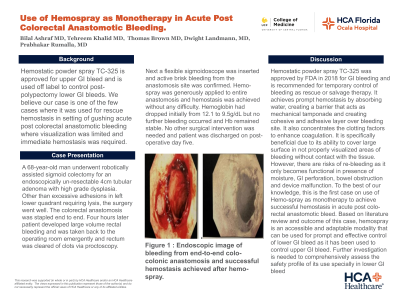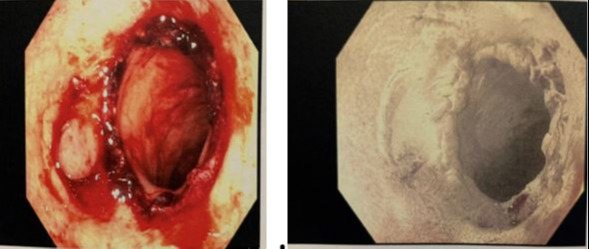Back


Poster Session B - Monday Morning
Category: GI Bleeding
B0322 - Use of Hemospray as Monotherapy in Acute Post Colorectal Anastomotic Bleeding
Monday, October 24, 2022
10:00 AM – 12:00 PM ET
Location: Crown Ballroom

Has Audio

Bilal Ashraf, MD
UCF College of Medicine-HCA GME Consortium/HCA Florida Ocala Hospital
Ocala, FL
Presenting Author(s)
Bilal Ashraf, MD1, Tehreem Khalid, MD2, Thomas Brown, MD1, Dwight Landmann, MD3, Prabhakar Rumalla, MD4
1UCF College of Medicine-HCA GME Consortium/HCA Florida Ocala Hospital, Ocala, FL; 2University of Central Florida/HCA Florida Ocala Hospital, Ocala, FL; 3AdventHealth Ocala, Ocala, FL; 4HCA Florida Ocala Hospital., Ocala, FL
Introduction: Hemostatic powder spray TC-325 is approved for upper GI bleed and is used off label to control post-polypectomy lower GI bleeds. We believe our case is one of the few cases where it was used for rescue hemostasis in setting of gushing acute post colorectal anastomotic bleeding where visualization was limited and immediate hemostasis was required.
Case Description/Methods: A 68-year-old man underwent robotically assisted sigmoid colectomy for an endoscopically un-resectable 4cm tubular adenoma with high grade dysplasia. Other than excessive adhesions in left lower quadrant requiring lysis, the surgery went well. The colorectal anastomosis was stapled end to end. Four hours later patient developed large volume rectal bleeding and was taken back to the operating room emergently and rectum was cleared of clots via proctoscopy. Next a flexible sigmoidoscope was inserted and active brisk bleeding from the anastomosis site was confirmed. Hemo-spray was generously applied to entire anastomosis and hemostasis was achieved without any difficulty. Hemoglobin had dropped initially from 12.1 to 9.5g/dL but no further bleeding occurred and Hb remained stable. No other surgical intervention was needed and patient was discharged on post-operative day five.
Discussion: Hemostatic powder spray TC-325 was approved by FDA in 2018 for GI bleeding and is recommended for temporary control of bleeding as rescue or salvage therapy. It achieves prompt hemostasis by absorbing water, creating a barrier that acts as mechanical tamponade and creating cohesive and adhesive layer over bleeding site. It also concentrates the clotting factors to enhance coagulation. It is specifically beneficial due to its ability to cover large surface in not properly visualized areas of bleeding without contact with the tissue. However, there are risks of re-bleeding as it only becomes functional in presence of moisture, GI perforation, bowel obstruction and device malfunction. To the best of our knowledge, this is the first case on use of Hemo-spray as monotherapy to achieve successful hemostasis in acute post colo-rectal anastomotic bleed. Based on literature review and outcome of this case, hemospray is an accessible and adaptable modality that can be used for prompt and effective control of lower GI bleed as it has been used to control upper GI bleed. Further investigation is needed to comprehensively assess the safety profile of its use specially in lower GI bleed

Disclosures:
Bilal Ashraf, MD1, Tehreem Khalid, MD2, Thomas Brown, MD1, Dwight Landmann, MD3, Prabhakar Rumalla, MD4. B0322 - Use of Hemospray as Monotherapy in Acute Post Colorectal Anastomotic Bleeding, ACG 2022 Annual Scientific Meeting Abstracts. Charlotte, NC: American College of Gastroenterology.
1UCF College of Medicine-HCA GME Consortium/HCA Florida Ocala Hospital, Ocala, FL; 2University of Central Florida/HCA Florida Ocala Hospital, Ocala, FL; 3AdventHealth Ocala, Ocala, FL; 4HCA Florida Ocala Hospital., Ocala, FL
Introduction: Hemostatic powder spray TC-325 is approved for upper GI bleed and is used off label to control post-polypectomy lower GI bleeds. We believe our case is one of the few cases where it was used for rescue hemostasis in setting of gushing acute post colorectal anastomotic bleeding where visualization was limited and immediate hemostasis was required.
Case Description/Methods: A 68-year-old man underwent robotically assisted sigmoid colectomy for an endoscopically un-resectable 4cm tubular adenoma with high grade dysplasia. Other than excessive adhesions in left lower quadrant requiring lysis, the surgery went well. The colorectal anastomosis was stapled end to end. Four hours later patient developed large volume rectal bleeding and was taken back to the operating room emergently and rectum was cleared of clots via proctoscopy. Next a flexible sigmoidoscope was inserted and active brisk bleeding from the anastomosis site was confirmed. Hemo-spray was generously applied to entire anastomosis and hemostasis was achieved without any difficulty. Hemoglobin had dropped initially from 12.1 to 9.5g/dL but no further bleeding occurred and Hb remained stable. No other surgical intervention was needed and patient was discharged on post-operative day five.
Discussion: Hemostatic powder spray TC-325 was approved by FDA in 2018 for GI bleeding and is recommended for temporary control of bleeding as rescue or salvage therapy. It achieves prompt hemostasis by absorbing water, creating a barrier that acts as mechanical tamponade and creating cohesive and adhesive layer over bleeding site. It also concentrates the clotting factors to enhance coagulation. It is specifically beneficial due to its ability to cover large surface in not properly visualized areas of bleeding without contact with the tissue. However, there are risks of re-bleeding as it only becomes functional in presence of moisture, GI perforation, bowel obstruction and device malfunction. To the best of our knowledge, this is the first case on use of Hemo-spray as monotherapy to achieve successful hemostasis in acute post colo-rectal anastomotic bleed. Based on literature review and outcome of this case, hemospray is an accessible and adaptable modality that can be used for prompt and effective control of lower GI bleed as it has been used to control upper GI bleed. Further investigation is needed to comprehensively assess the safety profile of its use specially in lower GI bleed

Figure: Endoscopic image of bleeding from end-to-end colo-colonic anastomosis and successful hemostasis achieved after hemo-spray.
Disclosures:
Bilal Ashraf indicated no relevant financial relationships.
Tehreem Khalid indicated no relevant financial relationships.
Thomas Brown indicated no relevant financial relationships.
Dwight Landmann indicated no relevant financial relationships.
Prabhakar Rumalla indicated no relevant financial relationships.
Bilal Ashraf, MD1, Tehreem Khalid, MD2, Thomas Brown, MD1, Dwight Landmann, MD3, Prabhakar Rumalla, MD4. B0322 - Use of Hemospray as Monotherapy in Acute Post Colorectal Anastomotic Bleeding, ACG 2022 Annual Scientific Meeting Abstracts. Charlotte, NC: American College of Gastroenterology.
